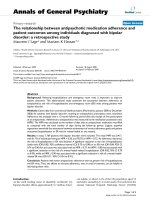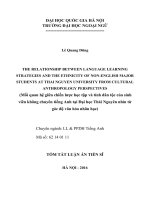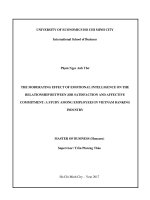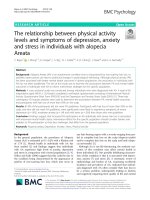Effect of Time Pressure to the Relationship between Organizational Innovation Climate and Creative Outcomes
Bạn đang xem bản rút gọn của tài liệu. Xem và tải ngay bản đầy đủ của tài liệu tại đây (159.02 KB, 10 trang )
THESIS PROPOSAL
Effect of Time Pressure to the Relationship between
Organizational Innovation Climate and Creative Outcomes
Student:
1
Truong Minh Ly
CHAPTER 1
INTRODUCTION
1.1. Research background
Nowadays, in the highly competitive marketplace, ability of making new
ideas, better ways, creative things is one of the main factors of a company’s
survival. Creativity is not only consider as an arsenal of a manager but also a
competitive disadvantage of a company. Creativity is the production of novel and
useful ideas in any domain and successful implementation of creative ideas within
an organization lead to innovation (Amabile et al, 1996). From that view, they show
that creativity by individuals and teams is a starting point for innovation. Thus,
creativity is at the individual level, while innovation is at the organizational level
(Oldham and Cummings, 1996).
There were many studies that related to the relationship between individual
and organizational creativity. In 1993, Redmond et al. showed that the individual
creativities are the ultimate source of any new idea while Shalley and Gilson (2004)
stated that creative outcomes provides the foundation for organizational innovation.
Hence, theoretically, the creative performance of employees provides the raw
material needed for organizational innovation (Oldham and Cummings, 1996).
Besides, creativity at the individual level, through idea generation and
implementation, is likely to lead to the development of innovative products at the
organizational level. Creativity of employees positively influences organizational
innovation and on the contrary, it is also under organizational innovation’s
influence.
This research is conducted in Vietnam. Acknowledge the results of previous
reseaches on the relationship between individual and organizational creativity, my
study only concentrates on the influence of time pressure to the above relationship
in Vietnam’s organization.
1.2. Research objectives
In this study, the author examines, gives comment and understands the role
of Time pressure in the relationship between Organizational Innovation Climate and
2
Creative Outcomes in Vietnam’s organizations. Accordingly, the study aims to
answer these below research questions:
Question 1: Is there the role of Time pressure in the relationship between
Organizational Innovation Climate and Creative Outcomes in the Vietnam’s
organizations?
Question 2: What is the relationship between Organizational Innovation
Climate and Creative Outcomes in the Vietnam’s organizations?
Question 3: Is this positive or negative effect?
Question 4: How can improve Organizational Innovation Climate and
Creative Outcomes in the Vietnam’s organizations under pressure of time?
1.3. Practical significances of the study
The results of the study are practically meaningful for impulse innovation
and creative process in Vietnam’s organizations. The study helps organization to
master the roles of Time pressure in the relationship between Organizational
Innovation Climate and Creative Outcomes in the Vietnam’s organizations. The
results of the study will provide necessary measures to improve innovation and
creative process, which results in improvement in performance and competition
capability. The study will also enrich necessary knowledge for people who are
wanting to have innovative as well as creative ideas.
1.4. Scope and approach
Based on the list of corporate that have implemented ERP systems, the
author attempts to conduct the study in twenty five companies in Ho Chi Minh,
Binh Duong and Dong Nai with “go live” ERP systems.
The study is conducted in 2 phase: pilot study and main study. The purpose
of pilot test is to test the content as well as the measurement of scales. Then the
main study is to test the hypotheses and research model.
1.5. Research method
The study was carried out within 2 steps relating to two different methods:
3
Qualitative method: The author would use the qualitative method by
carrying out group discussions with five experienced people working in the field of
ERP business. The purpose of this step is to adjust and amend the translated
questionnaire suitable with the subjects and purposes of the study.
Quantitative method: Quantitative study would be carried out based on the
data collected from the questionnaire. Quantitative study is implemented to evaluate
the scale, verify the theoretical model. The scale is preliminarily tested the
reliability and validity using Cronbach alpha and exploratory factor analysis carried
out by the SPSS 20.0 software. Multiple linear regression analysis and hierarchical
regression would be used to test the proposed model and the hypotheses of the
study.
1.6. Structure of the thesis
This study includes 5 chapters:
Chapter 1- Introduction, mentions about research background, research objectives
and research scope and approach.
Chapter 2 – Literature review, provides theoretical and empirical background
supporting for hypothesized research model.
Chapter 3 – Research methodology, is about the methodologies that author used to
conduct the research.
Chapter 4 – Data analysis and findings, discusses about the analysis that author
conduct to test hypothesis and to answer the research question.
Chapter 5 - Conclusion and implication, is about the results, implication, and
recommendation for future research.
4
CHAPTER 2
LITERATURE REVIEW
4. Literature review:
4.1. Terms’ definition:
- What is creativity? How many creative’s definitions are there?
- What is innovation? What differences between creative and innovation?
- Time pressure
- Organizational Innovation Climate
- Creative Outcomes
- Psychometrics
4.2. Theories of creativity and innovation:
a) Goran Ekvall, professor emeritus of organizational psychology at the University of
Lund, Sweden spent many years looking at the organizational climatic dimensions which
affects organizational creativity.
Creativity is not something
b) Ekvall's Studies in 70's & 80's
that can be 'turned on' at will,
Ekval took a representative sample of 27 different but rather by the result of long
exposure
to
an
organizations and divided them into Innovative(8), term
encouraging climate"
D.
Stagnated(4) and Average(15) industries.
Turnipseed
Innovative refers to the ability to develop new products
and services quickly, get to market more efficiently and have products with high
commercial success. stagnated refers to an inability to effectively handle newness and have
products which were not as successful.
c) Another instrument is KEYS: Assessing the Climate for Creativity
This approach assesses perceived stimulants and obstacles to creativity in the
organizational work environment. The key dimensions of creativity are encouragement of
creativity (organizational, supervisory and work group encouragement), autonomy /
freedom, resources, pressures, and organizational impediments to creativity.
KEYS was developed by Teresa Amabile, at Harvard University
5
Incrementalism is Innovation's worst enemy
N.
KEYS
Negroponte
Developed for Center for Creative Leadership by
Teresa Amabile, KEYS is a survey instrument which assesses those aspects of the work
environment which stimulates or inhibits creativity. It does not consider all possible
dimensions of the work environment but targets those which significantly influence
creativity.
It is a 78-item paper-and-pencil survey each describing a characteristic of the work
environment and scored on a numerical scale to rate the degree to which that characteristic
describes the current work environment. Theses item ratings form 8 environment scales (6
stimulants and 2 obstacles to creativity) and 2 outcome scales (creativity and productivity
in the work).
Stimulants to Creativity
Organizational Encouragement of creativity (15 items):
•
•
•
•
fair, constructive judgment of ideas
reward and recognition
mechanisms for developing new ideas
shared vision
Supervisory Encouragement of Creativity (11 items):
Work Group Supports (8 items):
•
•
•
•
communicate
openness to new ideas
constructive challenge
trust
Freedom (4 items):
•
•
•
what work to do
how to do it
control over one's work.
Sufficient Resources (6 items):
•
•
•
people
funds
facilities
6
•
information.
Challenging Work (5 items):
Obstacles to Creativity
Organizational Impediments (12 items):
•
•
•
•
•
internal political
criticism of new ideas
destructive internal competition
risk avoidance
overemphasis on the status quo.
Workload Pressure (5 items):
unrealistic expectations for productivity
We propose that time pressure, in the moderate to high levels generally experienced in
contemporary organizations, has a direct negative effect on creative cognitive processing.
According to the componential theory, creativity is determined by the effects of one extraindividual (outside the person) component and three intraindividual (inside the person)
components on creative cognitive processing. The extraindividual component is the
external work environment, consisting of several features of the organizational climate, the
work group climate, managerial behaviors, and task constraints – including time pressure
for getting the work done. The theory focuses on an indirect route by which the work
environment might influence creativity – through influences on the intra-individual
components. However, although it is not explicitly predicted by the theory, a direct effect
of time pressure is suggested by a metaphor in the most recent revision of the theory
(Amabile, 1996). According to this metaphor, doing a task or solving a problem is like
getting through a maze; the comparison derives from Newell, Shaw, and Simon’s (1962)
notion that creativity depends on the exploration of the maze of available cognitive
pathways. Although satisfactory outcomes can be attained by following a straight path (a
familiar task algorithm) out of the maze, creative solutions require exploration of
unfamiliar territory. One recent laboratory study designed to examine the applicability of
this maze metaphor revealed that people who allocate more time to exploratory task
behaviors are more likely to produce work that is rated by observers as creative (Ruscio,
Whitney, & Amabile, 1998).
6. Research hypothesis:
Hο1: Employees who perceive a high level of organizational innovation climate will
demonstrate a high level of creative outcomes at work
Ho2: Time pressure moderates the positive relationship between organizational innovation
climate and creative outcomes. Employees who work under reduced time pressure
demonstrate a high level of creative outcome, when they perceive a high level
organizational innovation climate.
7. Research Methodology and model:
7.1 Sample:
Employees working in Green Power – 35 Ton Duc Thang Street, District 1
7
7.2. Measure:
This study took the form of a self assessed survey using a six-point Likert scaled, as well
as Keys scale of Teresa M. Amabile. The data gathered was stored automatically in a form
that could be used easily for data analysis by SPSS software and give recommendations.
Observed variables:
- Creative outcome
- Organizational innovation climate
- Time pressure
Control variable:
- Educational level
7.3. Model:
8
Time Pressure
Organizational
innovation climate
Creative outcome
8. References:
Amabile, Teresa M., Conti, R., Coon, H., Lazenby, J., & Herron, M. (1996). Assessing the
working environment for creativity. Academy of Management Journal, 39, 1154-1184.
Amabile, Teresa M. (1996). Managing for Creativity. Harvard Business School, 9-396271.
Amabile, Teresa M. (1997). Motivating Creativity in Organizations: On doing what you
love and loving what you do. California management review, Vol. 40, No. 1.
Amabile, Teresa M., Barsade, Sigal G., Mueller, Jennifer S., Staw, Barry M. (2005). Affect
and Creativity at work. Johnson Graduate School, Cornell University, 0001-8392/05/50030367/$3.00.
Culpepper, Mary Kay (2010). KEYS to Creativity and Innovation: An Adopt – A –
Measure Examination. The International Center for Studies in Creativity, Buffalo State
College, CRS 580.
Grant, Adam M., Berry, James W., (2011). The necessity of others is the mother of
invention: Intrinsic and prosocial motivations, perspective taking, and creativity. Academy
of Management Journal, Vol. 54, No. 1, 73-96.
Hsu, Michael L. A. (2010). Organizational Innovation Climate and Creative Outcomes:
Exploring the Moderating Effect of Time Pressure. Creativity research journal, 22(4), 378386, 2010.
Mishra, L. K., Singh, A. P. (2010). Creative Behavior Questionnaire: Assessing the Ability
of Managers to Produce Creative Ideas. Journal of the Indian Academy of Applied
Psychology, Vol. 36, No. 1, 115-121.
Certification of instructor
Student
Phạm Quốc Hùng
Trương Minh Lý
9
I. Creative outcomes: A six-point Likert scale was used (1¼strongly
disagree and 6¼strongly agree).
1. I believe that I am currently very creative in my work
2. A great deal of creativity is called for in my daily work
3. Overall, my current work environment is conducive to my own creativity.
4. At work, I always promote and champion ideas to others
5. I always investigate and secure the funds needed to implement new ideas.
II. Organizational innovation climate (Keys):
1. Organizational encouragement
2. Supervisory encouragement
3. Workgroup support
4. Freedom
5. Sufficient resources
6. Challenging work
7. Organizational impediments
III. Time pressure (Keys):
1. Time pressure in the work:
- At 7:30 this morning, my team leader asked me what my game-plan was for the
day, and could I be available for a roll-out meeting. I wrote out on a flip-chart what
I thought needed to be done today, looked at the list, and told her it was 2 or 3 days
of work.
2. Workload Pressure:
- I feel a sense of time pressure in my work and I have too much work to do in too
little time
3. The time pressure was pretty extreme today (theo Time Pressure and creativity –
Amabile)
4. I had way too many things to do today
IV. Intrinsic motivation:
Today, in my work on the target project, I felt…
a. involved in my work
b. I enjoyed my work
c. motivated by interest in my work
d. challenged by my work
V. Creative cognitive processing
a. Problem or task identification (“I found out that some code I thought was working
really isn’t.”);
b. Preparation (“I talked with a professor from the university concerning photolytic
metallization technology. … I’m beginning to get some general sense of where I can
take this concept and broaden it.”);
c. Response generation (“Working with two team-mates, I came up with an idea to
eliminate the mismatch between [two elements of the hardware].”);
d. Response validation and communication (“I tried out my pattern adhesive […] in
the lab. [It] didn’t really work well, but I made some interesting observations that help
me understand the problem a little better.”)
IV. Educational level (Control variable):
10









